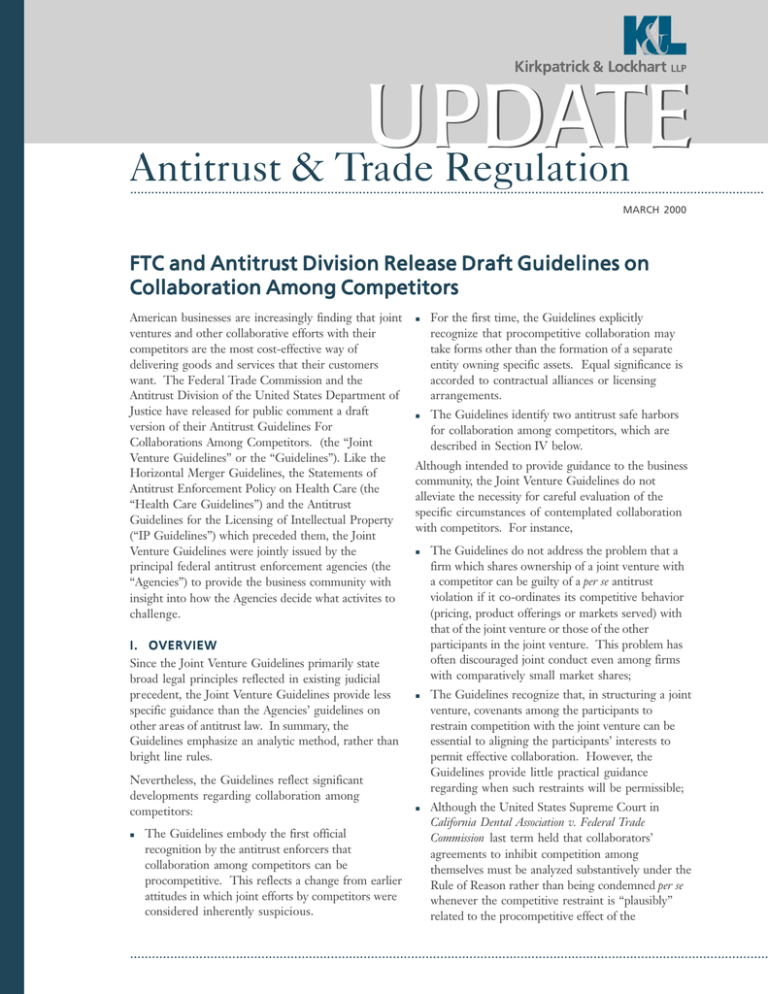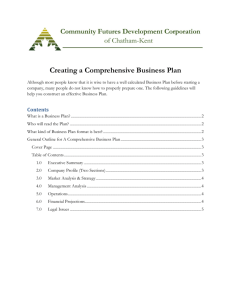
UPDATE
Antitrust & Trade Regulation
....................................................................................................................................................................................
MARCH 2000
FTC and Antitrust Division Release Draft Guidelines on
Collaboration Among Competitors
American businesses are increasingly finding that joint
ventures and other collaborative efforts with their
competitors are the most cost-effective way of
delivering goods and services that their customers
want. The Federal Trade Commission and the
Antitrust Division of the United States Department of
Justice have released for public comment a draft
version of their Antitrust Guidelines For
Collaborations Among Competitors. (the “Joint
Venture Guidelines” or the “Guidelines”). Like the
Horizontal Merger Guidelines, the Statements of
Antitrust Enforcement Policy on Health Care (the
“Health Care Guidelines”) and the Antitrust
Guidelines for the Licensing of Intellectual Property
(“IP Guidelines”) which preceded them, the Joint
Venture Guidelines were jointly issued by the
principal federal antitrust enforcement agencies (the
“Agencies”) to provide the business community with
insight into how the Agencies decide what activites to
challenge.
I. OVERVIEW
Since the Joint Venture Guidelines primarily state
broad legal principles reflected in existing judicial
precedent, the Joint Venture Guidelines provide less
specific guidance than the Agencies’ guidelines on
other areas of antitrust law. In summary, the
Guidelines emphasize an analytic method, rather than
bright line rules.
Nevertheless, the Guidelines reflect significant
developments regarding collaboration among
competitors:
The Guidelines embody the first official
recognition by the antitrust enforcers that
collaboration among competitors can be
procompetitive. This reflects a change from earlier
attitudes in which joint efforts by competitors were
considered inherently suspicious.
For the first time, the Guidelines explicitly
recognize that procompetitive collaboration may
take forms other than the formation of a separate
entity owning specific assets. Equal significance is
accorded to contractual alliances or licensing
arrangements.
The Guidelines identify two antitrust safe harbors
for collaboration among competitors, which are
described in Section IV below.
Although intended to provide guidance to the business
community, the Joint Venture Guidelines do not
alleviate the necessity for careful evaluation of the
specific circumstances of contemplated collaboration
with competitors. For instance,
The Guidelines do not address the problem that a
firm which shares ownership of a joint venture with
a competitor can be guilty of a per se antitrust
violation if it co-ordinates its competitive behavior
(pricing, product offerings or markets served) with
that of the joint venture or those of the other
participants in the joint venture. This problem has
often discouraged joint conduct even among firms
with comparatively small market shares;
The Guidelines recognize that, in structuring a joint
venture, covenants among the participants to
restrain competition with the joint venture can be
essential to aligning the participants’ interests to
permit effective collaboration. However, the
Guidelines provide little practical guidance
regarding when such restraints will be permissible;
Although the United States Supreme Court in
California Dental Association v. Federal Trade
Commission last term held that collaborators’
agreements to inhibit competition among
themselves must be analyzed substantively under the
Rule of Reason rather than being condemned per se
whenever the competitive restraint is “plausibly”
related to the procompetitive effect of the
...............................................................................................................................................................................
....................................................................................................................................................................................
collaboration, the Guidelines propose to apply the
more restrictive standard of per se illegality unless
the joint venturers can meet the arguably more
demanding standard of demonstrating that the
restraint is “reasonably necessary” to the
procompetitive effect;
The Joint Venture Guidelines make clear, by
comparison with the Agencies’ earlier Guidelines,
that the broader safe harbor outlined in the Health
Care Guidelines for cooperative purchasing will,
contrary to most practitioners’ expectations, be
confined to the health care markets. In all other
circumstances, analogous conduct will be subject to
the more restrictive safe harbor described in the
Joint Venture Guidelines;
arrangement as to make separate evaluation
meaningless. Accordingly, the Agencies may not only
challenge the totality of a collaboration, but may
instead challenge one provision (traditionally referred
to as an “ancillary restraint”) which is part of a
collaboration, the existence of which goes
unchallenged.
Moreover, the Agencies will evaluate the competitive
effects of the collaboration not only as of the time the
collaboration is formed, but also as of any later date at
which the collaboration impairs competition. Thus, a
joint venture which was not a problem when it was
formed may be attacked later because of exogenous
changes in the market in which it functions. On the
other hand, the Guidelines extend assurances that, in
The Guidelines focus solely upon the issue of when assessing a joint venture after the collaboration has
limitations upon competition among the
been in operation, the Agencies will be sensitive “to the
participants in the collaborative activity may create reasonable expectations of participants whose
a violation of the antitrust laws, foregoing any
significant sunk cost investments in reliance on the
comment upon the often equally important question relevant agreement were made before it became
of whether exclusionary effects of the arrangement
anticompetitive.”
(i.e., excluding participation by other competitors)
may render the collaboration unlawful;
III. LEGAL ST
ANDARDS
STANDARDS
The Guidelines provide that, in varying circumstances,
Since the Guidelines only apply where competitors
any of three different standards will be utilized to judge
form a collaboration, they do not discuss the
circumstances in which a collaboration among
the legality of a competitor collaboration:
customers and suppliers will be deemed unlawful
the standard of per se illegality,
because it forecloses too much competition at either
the Rule of Reason standard, and
level of distribution.
the merger standard.
II.
APPLICA
TION OF THE GUIDELINES
APPLICATION
The Guidelines cover a much broader scope of
collaborative activity than the traditional joint venture
in which the participants set up a corporation,
partnership, limited liability company or other entity as
the vehicle for cooperation. The Guidelines stipulate
that they will be used by the enforcement agencies to
evaluate any “set of one or more agreements, other than
merger agreements, between or among competitors to
engage in economic activity, and the economic activity
resulting therefrom.” The term “competitors” is used
in the Guidelines to encompass both traditional
competitors already operating in the same product and
geographic markets and potential competitors. Since
the Guidelines generally apply to agreements among
competitors other than mergers, they will be used to
evaluate, in addition to traditional joint ventures, a
variety of joint research and development efforts,
technology licensing arrangements, strategic alliances
and other purely contractual undertakings.
Per se illegality
Some types of agreements are automatically considered
illegal because they have no significant competitive
benefits. Instead, such agreements always or almost
always tend to raise prices or to reduce output. Such
agreements are considered by the courts not worthy of
the time required to complete a particularized analysis
of their effects. Typically these are agreements not to
compete on price or output, including agreements to
fix prices, to rig bids, or to divide the market by
allocating customers, territories or products.
Agreements of a type that otherwise would be
considered per se illegal, however, are nevertheless
analyzed under the more lenient Rule of Reason if they
are reasonably necessary to achieve the procompetitive
benefits of an efficiency-enhancing integration of
economic activity. In an efficiency-enhancing
integration, participants collaborate to perform (or
cause to be performed) one or more business functions,
such as production, distribution or research and
The Guidelines assess the competitive effects of the
development. Typically they combine, “by contract or
collaborative arrangement as a whole. However, they
otherwise,” significant capital, technology or other
also isolate for review each individual covenant, unless complementary assets to achieve procompetitive
the covenant is so intertwined with the remainder of the benefits that neither participant could achieve
....................................................................................................................................................................................
...............................................................................................................................................................................................
separately. The procompetitive benefits of such
integration ordinarily are an expansion of output, a
reduction of costs and prices, an enhancement of
quality or an increase in innovation.
However, the Guidelines point out, mere coordination
of decisions on price, output, customers, products or
territories is not integration and is not sufficient to
escape per se condemnation. Nor are mere “cost
savings without integration” a basis for avoiding per se
illegality. Thus, actual integration of economic
activity is critical to avoiding per se treatment.
Even where there is integration, however, a
restraint on competition will be lawful only where
it is “reasonably necessary” to obtaining the
benefits of integration. Under the Guidelines, a
covenant restricting competition will not be
considered “reasonably necessary” if the
participants could achieve “an equivalent or
comparable efficiency-enhancing integration
through practical, significantly less restrictive
means.” The Guidelines assert, however, that the
Agencies will not invalidate a restrictive covenant
on the basis of “a theoretically less restrictive
alternative that was not practical given the business
realities.”
Rule of Reason
Under the Rule of Reason, the central inquiry is
whether the relevant agreement harms competition by
increasing the participants’ incentive or ability to
raise prices or to reduce output, quality, service or
innovation below what would likely prevail in the
absence of the agreement. The Rule of Reason
analysis focuses on the state of competition with, as
compared to without, the agreement under analysis.
Factors considered under the Rule of Reason analysis
include:
the nature and purpose of the agreement, including
the extent to which it limits independent
decisionmaking or combines the participants’
financial interests;
the extent to which the collaboration facilitates
collusion through information-sharing;
the market shares of the participants and the
concentration of the market;
Markets affected may include not only markets
for goods and services, but also markets for
technology (where intellectual property is sold
separately) and even a market for innovation
itself where the capacity to engage in research
and development is associated with specialized
assets.
To evaluate the effect of a joint venture on
market concentration, the Agencies do not
assign to the venture a determinate market
share, but rather a range of market shares. The
low point of the range is the share of the joint
venture alone; the high point is the combined
share of the joint venture and each of the
participants which is independently present in
the market.
the extent to which the participants in the
collaboration have the ability and an incentive to
compete among themselves;
Since participants in a joint venture may either
continue to compete independently of the joint
venture or confine their activities to the joint
venture, the extent to which competition among
the participants endures can significantly affect
the impact of the joint venture. Considerations
which can influence the incentive to compete
include: (i) whether there is an explicit
commitment to exclusivity; (ii) whether the
participants have actually competed following
the establishment of the joint venture;
(iii) whether the agreement requires the
participants to contribute significant assets that
would be difficult to replace; (iv) the relative
magnitude of the participants’ financial interests
in the joint venture and in their independent
activities; and (v) the extent to which the joint
activity’s governance structure enables the
collaboration to make independent decisions.
the duration of the collaboration;
the likelihood that others will enter the market, as
well as the time required for such entry and scale
on which entry is likely to occur;
any procompetitive benefits of the collaboration
which can be verified by the Agencies, provided
that the agreement is reasonably necessary to
achieve those benefits. Cost savings that arise from
output or service reductions, however, will not be
recognized by the Agencies.
Consistent with judicial precedent, the Agencies
undertake no more extensive factual analysis than the
specific circumstances require. In some cases, the nature
of the agreement and the absence of market power
together may demonstrate the absence of competitive
harm. In such cases, the Agencies will cut short their
analysis and will not challenge the agreement.
Alternatively, where the likelihood of harm to
competition is obvious from the nature of the agreement
or competitive harm has already occurred, and where
there are no overriding benefits that could offset the
competitive harm, the Agencies will challenge such an
agreement without doing a detailed market analysis.
...............................................................................................................................................................................................
.........................................................................................................................................................
Merger Standard
Competitor collaborations are generally viewed by the
Agencies as distinct from mergers for at least two
reasons. First, mergers completely end competition
between the merging parties. Second, mergers are
designed to be permanent, whereas competitor
collaborations are more typically of limited duration.
Accordingly, the Agencies will ordinarily evaluate a
collaboration under a different analytical framework
than a merger. However, the Agencies will treat a
competitor collaboration as a merger and analyze the
collaboration pursuant to the Horizontal Merger
Guidelines if:
percent of each relevant market in which competition
may be affected. For purchasing cooperatives, this safe
harbor is considerably narrower than that for health
care purchasing cooperatives outlined in the Health
Care Guidelines. Under the Health Care Guidelines,
the Agencies ordinarily will not attack a purchasing
joint venture as long as the joint purchases account for
less than 35 percent of the total sales of the purchased
product or service and the costs of the products or
services purchased jointly account for less than 20
percent of the total revenues from all products or
services sold by the participants in the joint purchasing
arrangement.
the participants are competitors in a relevant
market;
The Guidelines establish a special safe harbor for
research and development collaborations because
the formation of the collaboration involves an
market shares in such activities are often difficult to
efficiency-enhancing integration of economic
determine. Research and development collaborations
activity in the relevant market;
will rarely be challenged based on competitive effects
in an innovation market where three or more
the integration eliminates all competition among
independently controlled research efforts (in addition
the participants in the relevant market; and
to those of the collaboration) possess both the required
the collaboration does not, by its own express terms,
specialized assets and the incentive to engage in
terminate within a sufficiently limited period
research and development that is a “close substitute”
(generally ten years).
for the research and development activity of the
collaboration.
IV
V.. SAFE HARBORS
The Guidelines describe certain “safety zones” in
Neither of these safety zones apply to agreements that
which anticompetitive effects are presumed to be so
are per se illegal, or that would be challenged without a
unlikely that the Agencies will treat the arrangements
detailed market analysis, or to those agreements that
as lawful without further inquiry. In general, the
are analyzed as mergers.
Agencies will not challenge a competitor collaboration
when the market shares of the collaboration and its
CONCLUSION
participants collectively account for no more than 20
The Joint Venture Guidelines give explicit recognition
to the concept that collaboration among competitors
can have important pro-competitive effects, and
The Antitrust and Trade Regulation Practice Group
provide a useful analytic framework for lawyers and
of Kirkpatrick & Lockhart LLP provides antitrust
judges to follow in analyzing such collaborations.
counseling to clients on achieving business
Nevertheless, they provide little concrete guidance
objectives while minimizing the risks of violating
regarding what the results of that analysis will be.
federal and state antitrust laws. For more
Decisions regarding whether to undertake any specific
information on our antitrust services, contact
collaboration with competitors must continue to be
Thomas A. Donovan (412.355.6466 or
based on a careful parsing by counsel and
tdonovan@kl.com) or James E. Scheuermann
knowledgeable business personnel of the specific facts
(412.355.6215 or jscheuermann@kl.com) in the
regarding the marketplace and the proposed
Pittsburgh office of K&L.
collaborative activity.
Thomas A. Donovan
Kirkpatrick & Lockhart LLP
Challenge us.
BOSTON
HARRISBURG
LOS ANGELES
MIAMI
NEW YORK
PITTSBURGH
WASHINGTON
.........................................................................................................................................................
This publication is for informational purposes and does not contain or convey legal advice. The information herein should
not be used or relied upon in regard to any particular facts or circumstances without first consulting with a lawyer.
© 2000 KIRKPATRICK & L OCKHART LLP.
ALL RIGHTS RESERVED.







